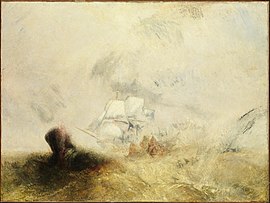
Whaling is the hunting of whales for their usable products such as meat and blubber, which can be turned into a type of oil that became increasingly important in the Industrial Revolution. It was practiced as an organized industry as early as 875 AD. By the 16th century, it had risen to be the principal industry in the Basque coastal regions of Spain and France. The whaling industry then spread throughout the world and became increasingly profitable in terms of trade and resources. Some regions of the world's oceans, along the animals' migration routes, had a particularly dense whale population, and became the targets for large concentrations of whaling ships, and the industry continued to grow well into the 20th century. The depletion of some whale species to near extinction led to the banning of whaling in many countries by 1969, and to an international cessation of whaling as an industry in the late 1980s.

The Sea Shepherd Conservation Society (SSCS) is a non-profit, marine conservation activism organization based in Friday Harbor on San Juan Island, Washington, in the United States. Sea Shepherd employs direct action tactics to achieve its goals, most famously by deploying its fleet of ships to track, report on and actively impede the work of fishing vessels believed to be engaged in illegal and unregulated activities causing the unsustainable exploitation of marine life.
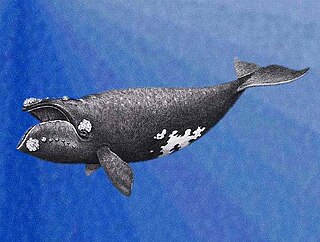
The North Pacific right whale is a very large, thickset baleen whale species that is extremely rare and endangered.
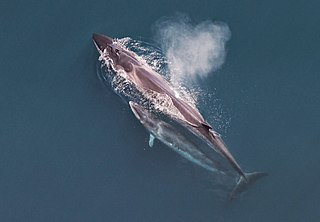
The sei whale is a baleen whale, the third-largest rorqual after the blue whale and the fin whale. It inhabits most oceans and adjoining seas, and prefers deep offshore waters. It avoids polar and tropical waters and semi-enclosed bodies of water. The sei whale migrates annually from cool, subpolar waters in summer to temperate, subtropical waters in winter with a lifespan of 70 years.
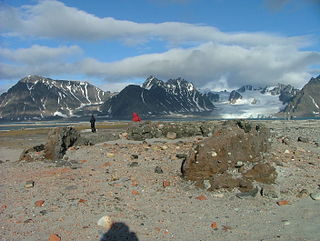
Smeerenburg was a whaling settlement on Amsterdam Island in northwest Svalbard. It was founded by the Danish and Dutch in 1619 as one of Europe's northernmost outposts. With the local bowhead whale population soon decimated and whaling developed into a pelagic industry, Smeerenburg was abandoned around 1660.
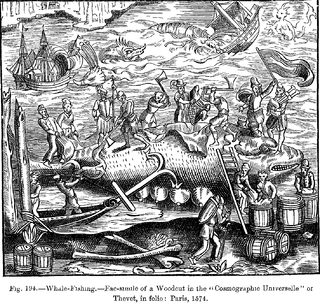
This article discusses the history of whaling from prehistoric times up to the commencement of the International Whaling Commission (IWC) moratorium on commercial whaling in 1986. Whaling has been an important subsistence and economic activity in multiple regions throughout human history. Commercial whaling dramatically reduced in importance during the 19th century due to the development of alternatives to whale oil for lighting, and the collapse in whale populations. Nevertheless, some nations continue to hunt whales even today.

A whaleboat is a type of open boat that was used for catching whales, or a boat of similar design that retained the name when used for a different purpose. Some whaleboats were used from whaling ships. Other whaleboats would operate from the shore. Later whaleboats usually could operate under sail or oar - American whaling crews in particular obtained better results by making their first approach to a whale under sail, then quickly unstepping the mast and using oars thereafter.

Charles W. Morgan is an American whaling ship built in 1841 that was active during the 19th and early 20th centuries. Ships of this type were used to harvest the blubber of whales for whale oil which was commonly used in lamps. Charles W. Morgan has served as a museum ship since the 1940s and is now an exhibit at the Mystic Seaport museum in Mystic, Connecticut. She is the world's oldest surviving (non-wrecked) merchant vessel, the only surviving wooden whaling ship from the 19th century American merchant fleet, and second to the USS Constitution, the oldest seaworthy vessel in the world. The Morgan was designated a National Historic Landmark in 1966.

Scrimshaw is scrollwork, engravings, and carvings done in bone or ivory. Typically it refers to the artwork created by whalers, engraved on the byproducts of whales, such as bones or cartilage. It is most commonly made out of the bones and teeth of sperm whales, the baleen of other whales, and the tusks of walruses.

Down to the Sea in Ships is a 1922 American silent romantic drama film about a 19th-century Massachusetts whaling family. Directed by Elmer Clifton, the film stars William Walcott, Marguerite Courtot, and Clara Bow. The film's title comes from Psalm 107, verses 23–24.

A whaler or whaling ship is a specialized vessel, designed or adapted for whaling: the catching or processing of whales.
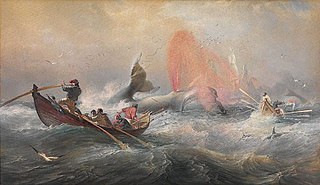
Whaling in Australian waters began in 1791 when five of the 11 ships in the Third Fleet landed their passengers and freight at Sydney Cove and then left Port Jackson to engage in whaling and seal hunting off the coast of Australia and New Zealand. The two main species hunted by such vessels in the early years were right and sperm whales. Humpback, bowhead and other whale species would later be taken.

Whaling was one of the first viable industries established in the Swan River Colony following the 1829 arrival of British settlers to Western Australia. The industry had numerous ups and downs until the last whaling station closed in Albany in 1978.

Whaling in the Netherlands was a centuries-long tradition. The history of Dutch whaling begins with 17th-century exploration of Arctic fishing grounds; and the profitability of whaling in the 18th century drove further growth. Increased competition and political upheavals in Europe affected the stability of this maritime industry in the 19th century; and a combination of these factors cut short any further growth of Dutch whaling in the Antarctic.

Commercial whaling in the United States dates to the 17th century in New England. The industry peaked in 1846–1852, and New Bedford, Massachusetts, sent out its last whaler, the John R. Mantra, in 1927. The Whaling industry was engaged with the production of three different raw materials: whale oil, spermaceti oil, and whalebone. Whale oil was the result of "trying-out" whale blubber by heating in water. It was a primary lubricant for machinery, whose expansion through the Industrial Revolution depended upon before the development of petroleum-based lubricants in the second half of the 19th century. Once the prized blubber and spermaceti had been extracted from the whale, the remaining majority of the carcass was discarded.

Whale conservation refers to the conservation of whales.
The Basques were among the first people to catch whales commercially, as opposed to aboriginal whaling, and dominated the trade for five centuries, spreading to the far corners of the North Atlantic and even reaching the South Atlantic. The French explorer Samuel de Champlain, when writing about Basque whaling in Terranova, described them as "the cleverest men at this fishing". By the early 17th century, other nations entered the trade in earnest, seeking the Basques as tutors, "for [they] were then the only people who understand whaling", lamented the English explorer Jonas Poole.

Commercial whaling in Britain began late in the 16th century and continued after the 1801 formation of the United Kingdom and intermittently until the middle of the 20th century.

A drift whale is a cetacean mammal that has died at sea and floated into shore. This is in contrast to a beached or stranded whale, which reaches land alive and may die there or regain safety in the ocean. Most cetaceans that die, from natural causes or predators, do not wind up on land; most die far offshore and sink deep to become novel ecological zones known as whale falls. Some species that wash ashore are scientifically dolphins, i.e. members of the family Delphinidae, but for ease of use, this article treats them all as "drift whales". For example, one species notorious for mass strandings is the pilot whale, also known as "blackfish", which is taxonomically a dolphin.
Whaling in Canada encompasses both aboriginal and commercial whaling, and has existed on all three Canadian oceans, Atlantic, Pacific, and Arctic. The indigenous peoples of the Pacific Northwest Coast have whaling traditions dating back millennia, and the hunting of cetaceans continues by Inuit. By the late 20th century, watching whales was a more profitable enterprise than hunting them.
